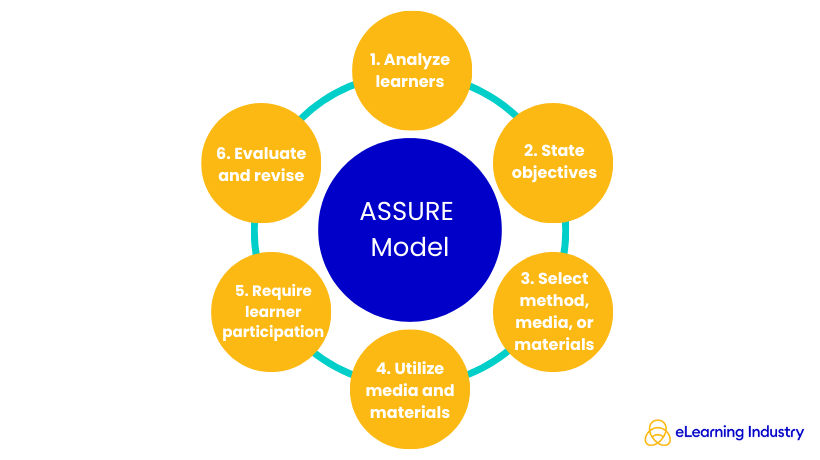What's The ASSURE Instructional Design Model?
Heinrich and Molenda created the ASSURE model in 1999. It is a well-known Instructional Design guide incorporating multimedia and technology to improve the learning environment from a constructivist perspective. Its name is an acronym for its components, which we'll see below. Let's dive deeper into the model and see how it can be applied in eLearning and how it benefits the overall learning experience.
The Model's 6 Components

1. Analyze Learners
The ASSURE model relies heavily on the learners, and its core is designed based on their needs. This is why the first step involves identifying the characteristics of the learners. Those can be their age, existing knowledge, education level, learning specificities, and a variety of other key details that are usually gathered through surveys and assessments. Once you've collected all the important info, you can start designing your lessons based on your learners' needs and preferences.
Here are the essential attributes that you must take into account:
- The learner's age, academic abilities, gender, capabilities, and interests are taken into account. Young learners require a more structured and detailed teaching model, whereas older learners can handle independent tasks and abstract concepts.
- Prior knowledge and skills are also taken into consideration. Assessing what the learner already knows is essential for determining the right starting point for them. This includes knowledge about a subject, their technical skills, and familiarity with certain concepts. The goal of the learning model must be to bridge the knowledge gaps and not to repeat what the learner already knows.
- The learning style is also an aspect that is taken into consideration. Some learners prefer auditory modules, while others prefer visual and tactile modules. It is important to recognize the learner's preference to drive more engagement and retention.
2. State Objectives
In the second step, you identify what learners should be able to do after completing the instructional materials. You can set objectives based on the SMART method, ensuring they are specific, measurable, achievable, relevant, and time-bound. This means that you should be able to precisely determine what skills and knowledge learners will acquire during a specific period. Additionally, you should set realistic goals relevant to the lessons to achieve the best learning outcome.
A good learning module must have four key components, outlined as the ABCDs.
- Audience (A): Who will be learning, or for whom is the model intended? They are defined as the "learners" or the "students."
- Behavior (B): What should the learner be able to do? This should be an action that is easy to measure and track. For instance, the learner should be able to identify something, explain a concept, or demonstrate an idea.
- Conditions (C): Under what conditions or situations should the learner demonstrate the behavior? This may include a particular setting, environment, or time limit.
- Degree (D): How well must the learner perform? This includes accuracy, speed, and quality.
3. Select Methods
Decide which instruction methods you'll use to deliver the content. For example, if your lessons are more instructor-led, choosing lectures, presentations, and other demonstrations is an ideal option. On the other hand, if they're more learner-centered, you should opt for group discussions and group activities. Once you've figured that out, you must choose the technology that will facilitate your teaching method. Here is a step-by-step process that will help you select the right method:
- First, consider which delivery method will be best for your module. For instance, there will be parts of your learning modules where you can utilize instructor-led delivery of content. Along with this, there will be some parts that will benefit from student-centered learning.
- Second, identify the modules that will benefit from either of the two types of learning modules. One key consideration is that the learning model should be primarily learner-led, with the instructor serving as a facilitator to help students achieve their goals. Learning becomes more interesting when the entire class participates in the process. The role of the teacher is only to deliver information and teach the students techniques. Ultimately, it is the student's responsibility to gain mastery over the subject.
- Third, it is time to select the technology, material, and media that will be used to support the teaching method. The technology can range from a simple chalkboard to PowerPoint and even Virtual Reality.
4. Utilize Media And Materials
Now it's time to plan how you'll utilize the methods you've chosen in the previous step. More specifically, you should review the technology and other media to ensure they'll run smoothly during your lessons and prepare them accordingly. In addition, you need to prepare the teaching environment. Lastly, inform the learners about the entire process, including the material, objectives, and assessment type.
There is a specific process, namely the five "P" process, to achieve this:
- Preview The Media, Material, And Technology
It is important to preview the media, materials, and educational technology that will be used to deliver the learning module. This will ensure that the lessons run smoothly. - Prepare The Media, Material, And Technology
Next comes preparing the materials. This includes gathering all the necessary equipment and resources to deliver the learning modules. - Preparing The Environment
You also need to set up the learning environment to ensure that you can deliver the materials seamlessly. - Preparing The Learners
Prepare the learner by providing them with a detailed overview of the learning process. Introduce them to the model and inform them of the assessment criteria. - Providing The Learning Experience
This phase is where you begin instructing the learners. For a successful delivery of the module, you must follow the steps mentioned above.
5. Require Learner Participation
Determine how you will actively engage your learners in the teaching process. For instance, you can establish mandatory participation in class discussions or ask them to guide the lesson themselves by asking questions or presenting themes for further analysis. You also need to consider how they will absorb the material.
6. Evaluate And Revise
In this final step, you must decide whether your material is effective and make revisions as necessary. Evaluate your teaching strategies, the media, the technology you used, and how you implemented them. Also, you should determine if the lessons and learners met your learning objectives and if the overall experience catered to their individual needs. Feedback from your learners is important in this step to help you with your analysis. You can prompt them to take surveys on how the lesson has impacted them, whether they're satisfied with the experience, and if they've achieved their personal goals. Lastly, give them the results of their assessments and feedback based on their performance.
How You Can Apply ASSURE To eLearning
The ASSURE model can be used when designing eLearning courses, as it ensures personalized and engaging learning experiences for every member of your audience. First of all, analyze learners to design lessons that fit their needs and preferences. Then, use your preferred LMS to state the objectives of the lessons, and deliver the chosen multimedia and support resources like videos, interactive quizzes, discussion forums, or even Virtual and Augmented Reality (VR/AR) activities. You can also leverage your LMS to collect user data, including learner participation, log-in information, and time spent on the platform. This, in addition to the online assessments and feedback from your learners, will allow you to evaluate the instructional process holistically.
The Benefits Of ASSURE
Focus On Learners
The ASSURE model provides a systematic approach to designing lessons. This means that it ensures that instructional technology materials focus on achieving specific learning outcomes and that learners are actively engaged in the learning process. Also, learners always know what they're expected to learn and how.
Varied Instructional Methods
The model encourages the use of a variety of instructional methods. Technology and media offer virtually endless options to choose from. This optimizes the learning process, making it more individualized and relevant. This freedom of choice enables designers to create lessons tailored to diverse learning needs and preferences.
Importance Of Evaluation
By emphasizing evaluation and revision, the model provides you with the opportunity to continually improve and update your content. Input from learners, as well as assessments, helps designers create experiences that stick and monitor learner performance as they progress.
Makes Learning More Engaging
Since the model focuses on creating structured, interactive, and learner-centered teaching, it enhances learner engagement and motivation. It takes into account the learners' attributes, which helps teachers to gain a deeper understanding of the students' backgrounds, capabilities, prior knowledge, and abilities. Moreover, the learners also have clarity about the expectations from a particular model and how they will be assessed. This makes them feel connected to the lesson and more motivated.
Along with the student, it also allows the teachers to select the appropriate method for learning. This prevents the learning process from being monotonous, thus further enhancing student learning and engagement.
Weaknesses Of The ASSURE Model
While the ASSURE model provides a structured and practical framework, it is not without its limitations. Here are some weaknesses of the model:
Excessive Focus On Academic Settings
The ASSURE model places too much emphasis on educational settings, making it less relevant in a workplace environment. Some even advocate that the model should be modified to meet the needs of a workplace setting.
It Is Time-Consuming
Although the model is easy to follow, many experts think that it requires a significant amount of time. Each step of the model, analyzing learners, selecting objectives, choosing methods, media, and evaluating outcomes, involves a lot of detailed planning. This can become very time-consuming, especially in an academic setting where teachers have a tight schedule and a vast syllabus to complete.
Excessive Emphasis On Technology
Although the model is helpful in modern classrooms, educational settings with limited resources will face challenges in its implementation. Schools with inadequate devices and limited resources will struggle to fully implement the model. This is why the model can't be implemented in rural schools and learning environments with limited funds.
Best Applications Of The ASSURE Model
The ASSURE model has its benefits and drawbacks. This is why, while it may be exceptionally beneficial for some programs, it may not be ideal for others.
The ASSURE model is best suited for blended learning and eLearning programs that use technologies such as Virtual Reality and Augmented Reality in their learning programs. The model emphasizes integrating technology into their learning module and is best suited for environments that have the required infrastructure to support it.
Along with this, the model's easy-to-follow approach makes it ideal for educators who want to plan lessons that are purposeful, engaging, and aligned with the learners' needs. Hence, the model is suitable for application in K-12 environments, adult education, and corporate training where learners have access to the required technological infrastructure.
Conclusion
The ASSURE model provides Instructional Designers with the power to create materials that are effective, engaging, and tailored to the needs of learners. Using this approach, you can create high-quality content that promotes active learning and maps out the entire process so that learners know where they're heading and how far they've come. You can also explore other ID strategies in our comprehensive list of Instructional Design models and theories.









